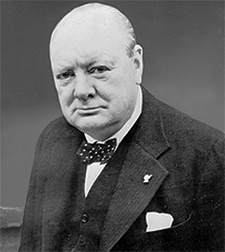What is it that makes Churchill so enduring and keeps him relevant in 2015 for CEOs?
Maybe most important, he exemplified the power and necessity of visible, public leadership -- something many current CEOs struggle with.
 Businesses increasingly recognize the value of articulating a clear corporate identity. Often, this is addressed in the form of a narrative that seeks to capture an organization's distinctive values, its customer commitments, its current brand attributes and its organizational aspirations.
Businesses increasingly recognize the value of articulating a clear corporate identity. Often, this is addressed in the form of a narrative that seeks to capture an organization's distinctive values, its customer commitments, its current brand attributes and its organizational aspirations.
When all a company's audiences are aligned around this distinct brand identity, powerful things occur. Think about the association between Apple and innovation or Daimler-Benz and quality. The Harvard Business Review recently reported that these strong identity companies out-perform their peers by 25%.
In today's competitive business environment, CEO visibility has become essential. CEOs are the x factor in corporate identity. They are best positioned to fashion an organization's mission and to build understanding and support for it from constituents.
This is crucial to seize that identity premium noted by HBR. A recent study found that almost half of an organization's market value is attributable to CEO reputation-building visibility.
I have found that these realities can be reluctantly accepted by CEOs. This is where Churchill comes in. The man they admire most knew that, by its very nature, leadership means rising to the potentialities of high office, being highly visible in order to persuade, connect and inspire.
During his wartime leadership, Churchill did for Britain what every CEO must be prepared to accomplish today. He educated key audiences about the qualities necessary for success, painted a bold vision for the future, and rallied all his constituents around these priorities.
Let's look at some specifics.
Leadership is visibility
It would have been easy for a prime minister in the throes of war to hunker down with a team of advisors and devote the lion's share of his energies to "running the war," out of the public eye. It's a modus operandi for many CEOs today. Churchill definitively rejected this course. He was ahead of his time not just in understanding the essential role of public visibility in leadership, but in publicly modeling attributes (courage and resilience) that his nation needed to embrace. CEOs can draw larger lessons here.
Public visibility can't be an afterthought. It is a vital component of CEO leadership. That doesn't mean CEOs must strive for Richard Branson type celebrity. It means making a commitment to deepening relationships with all the keepers of a company's reputation including employees, journalists, investors, customers and others, and engaging them through various channels of communication, both traditional and interactive. This requires careful planning, precise targeting, realistic prioritizing, and careful execution.
It's not always easy commandeering CEO time for these activities. But the payback can be dramatic, as Steve Jobs illustrated at Apple.
Visibility under crisis
CEOs are sometimes thrust into the public eye unwittingly, when negative news or crisis strikes. Too often, they've kept a low profile up until then, and they're unprepared for the limelight. This is another reason why the pursuit of visibility during normal times is so important. Churchill's speeches serve CEOs as a crisis communication textbook. His defined three principles of CEO communication during times of challenge:
• Candor. Churchill never spared his audience hard truths or sugarcoated reality; this was, paradoxically, the basis of his trust and credibility.
• Direction. Although he described a future with risk and hardship, Churchill usually inspired his audiences by illuminating a clear a path forward to safer and more prosperous times.
• Commitment. Churchill promised his and his team's investment of time and energy to lead though challenge, and demonstrated that in his subsequent actions.
Walking the Talk
Leadership "face time" is indispensable for building morale and commitment within the organization, and should be an integral part of every CEO's visibility agenda.
Churchill expertly leveraged this human quality of leadership. For example, at the height of the London blitz he regularly visited bombsites, meeting residents and hearing their stories. During one such visit, surprised by an air raid, he repaired to a bomb shelter, replacing his ever-present bowler with a helmet.
In today's environment, where employee morale can be a huge driver of growth, the best CEO's regularly walk the talk. When Southwest Airlines acquired AirTran in 2012, Southwest CEO Gary Kelly commandeered a hanger and hosted a giant "welcome to the family" barbeque for 6,000 AirTran employees. It was an inspired step for a perennial "Best Place to Work" company.
Overcoming obstacles
Occasionally, I hear a CEO explain that he or she won't elevate their visibility because "they're not good with the media." I often consider this as an excuse, because I believe that anyone who has risen to corporate leadership can be trained to be a capable media spokesperson.
Again, Churchill holds lessons. Few realize that one of the world's great "natural communicators" had a speech impediment — variously described as a lisp or a stutter. As a young man, Churchill visited speech pathologists and worked relentlessly to overcome the problem. He spoke with a slight lisp most of his life.
Visibility is an essential, undeniable component of contemporary CEO leadership.
That fact, and ideas for visible and inspirations leadership, are clear teachings from the leader CEOs admire the most.
Kenneth Makovsky is CEO of Makovsky.


 Business leaders will face challenges in the upcoming year, some of which will come as a complete surprise, or beyond anyone's imagination.
Business leaders will face challenges in the upcoming year, some of which will come as a complete surprise, or beyond anyone's imagination. Teneo has hired Philipp Grontzki, who is a 20-year veteran of corporate communications and financial journalism, as a managing director in its strategy and communications group.
Teneo has hired Philipp Grontzki, who is a 20-year veteran of corporate communications and financial journalism, as a managing director in its strategy and communications group. Rowan Benecke, who co-founded Zeno Group and helmed Burson-Marsteller's tech practice, has joined McKinsey & Co as director of communications for North America.
Rowan Benecke, who co-founded Zeno Group and helmed Burson-Marsteller's tech practice, has joined McKinsey & Co as director of communications for North America. BCW has named Golin's Matt Coldagelli EVP and leader of its corporate affairs practice in Chicago.
BCW has named Golin's Matt Coldagelli EVP and leader of its corporate affairs practice in Chicago. Abby Bailey, who headed corporate communications for Fedex in its Middle East, India and Africa region, has joined Teneo as managing director in Dubai.
Abby Bailey, who headed corporate communications for Fedex in its Middle East, India and Africa region, has joined Teneo as managing director in Dubai.


 Have a comment? Send it to
Have a comment? Send it to 
No comments have been submitted for this story yet.